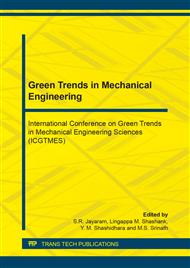[1]
Gillespie, L.K. and Blotter, P.T., The formation and properties of machining burrs, Transactions of ASME, Journal of Engineering for Industry, Vol. 98, 1976,p.66–74.
DOI: 10.1115/1.3438875
Google Scholar
[2]
Kim, J. and Dornfeld, D.A., Development of an analytical model for drilling burr formation in ductile materials, Tran. ASME, Journal of Engineering Materials and Technology, Vol. 124, 2003, p.192–198.
DOI: 10.1115/1.1429937
Google Scholar
[3]
Ko, S.L. and Lee, J., Analysis of burr formation in drilling with a new-concept drill, Journal of Materials Processing Technology, Vol. 113, 2001, p.392–398.
DOI: 10.1016/s0924-0136(01)00717-8
Google Scholar
[4]
Ko, S.L., Chang, J.E. and Yang, G.E., Burr minimizing scheme in drilling, Journal of Materials Processing Technology, Vol. 140, 2003, p.237–242.
DOI: 10.1016/s0924-0136(03)00719-2
Google Scholar
[5]
Ko, S.L. and Chang, J.E., Development of drill geometry for burr minimization in drilling', Annals of CIRP – Manufacturing Technology, Vol. 52, 2003, p.45–48.
DOI: 10.1016/s0007-8506(07)60527-7
Google Scholar
[6]
Lin, T.R. and Shyu, R.F., Improvement of tool life and exit burr using variable feeds when drilling stainless steel with coated drills, International Journal of Advanced Manufacturing Technology, Vol. 16, 2000, p.308–313.
DOI: 10.1007/s001700050162
Google Scholar
[7]
Min, S. and Dornfeld, D.A., Influence of exit surface angle on drilling burr formation, Transactions of ASME Journal of Manufacturing Science and Engineering, Vol. 125, 2003, p.637–644.
DOI: 10.1115/1.1596573
Google Scholar
[8]
Pande, S.S. and Relekar, H., Investigations on reducing burr formation in drilling, International Journal of Machine Tool Design and Research, Vol. 26, 1986, p.339–348.
DOI: 10.1016/0020-7357(86)90010-7
Google Scholar
[9]
Xia, R.S. and Mahadavian, S.M., Experimental studies of step drills and establishment of empirical equations for the drilling process, International Journal of Machine Tools and Manufacture, Vol. 45, 2004, p.235–240.
DOI: 10.1016/j.ijmachtools.2004.07.002
Google Scholar
[10]
Ch. Ramu, N.K. Mehta, Kumar.P and A.G. Shankara Murthy, Experimental investigations to optimise step drill geometry for burr minimisation in drilling using regression model, Int. J. Manufacturing Technology and Management, Vol. 21, Nos. 1/2, 2010, pp.122-134.
DOI: 10.1504/ijmtm.2010.034291
Google Scholar
[11]
Shankara Murthy A.G., Ph.d thesis, IIT Roorkee, (2010).
Google Scholar
[12]
Montgomery, D.C., Design and Analysis of Experiments, John Wiley & Sons, 2004, ISBN: 0471316490.
Google Scholar


